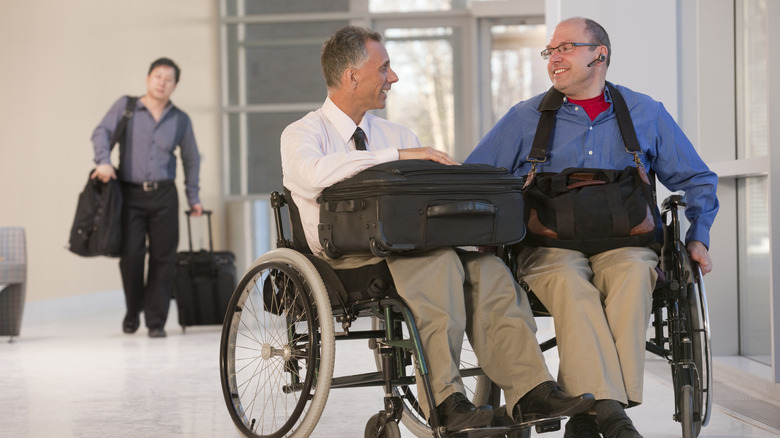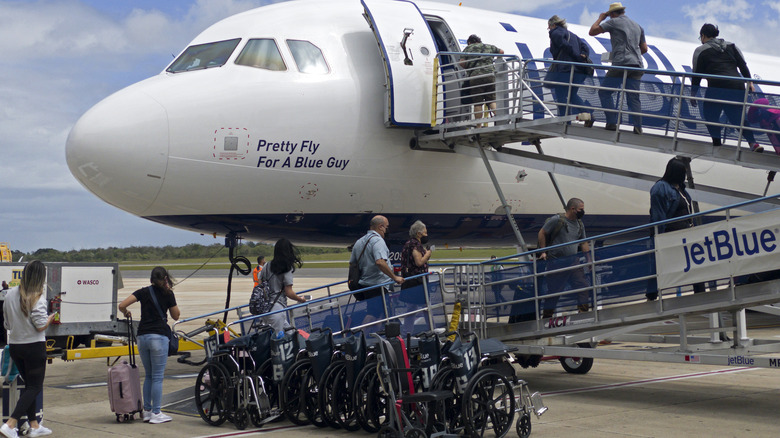Take These Steps Immediately If An Airline Mishandles Your Wheelchair And Causes Damage
It's a situation that no wheelchair user wants to face — arriving at your destination only to find that the airline has damaged your wheelchair. While this shouldn't happen, it's unfortunately more common than you would hope. According to the latest Air Travel Consumer Report, released by the Department of Transportation, 913 wheelchairs and scooters were mishandled in June 2025. That means that a little over one out of every 100 wheelchairs or scooters that made it onto planes had issues upon arrival. That may not seem like a lot, but those odds aren't great for travelers who rely on wheelchairs.
If you are unlucky enough to have your wheelchair mishandled, here's what you should do right away. First, take photos of any damage and note down what occurred so that you will have it recorded for the future. This is important when making a claim with the airline, as the DOT's Bill of Rights for Airline Passengers with Disabilities states that "airlines must provide compensation in an amount up to the original purchase price of the wheelchair or device" in cases of loss, damage, or destruction. You'll also want to request a replacement wheelchair, ensuring that you're told how long it will take to arrive.
In December 2024, the DOT announced sweeping protections for wheelchair travelers. These provisions include enhanced training for wheelchair support staff at airports as well as employees who handle wheelchairs. While many of them are tied up in a lawsuit filed by the trade association Airlines for America, others have already been implemented. This includes the quick replacement or repair of lost or damaged equipment, ensuring that delayed wheelchairs and scooters are returned to their owners within a set timeframe, and payments for transportation costs associated with losses or delays.
What are your rights when traveling with a wheelchair?
Sadly, the United States isn't the only country where mobility equipment is often mishandled. Following a highly publicized incident involving Air Canada in 2022, when the airline caused extensive damage to a woman's $30,000 motorized wheelchair on a flight to Tel Aviv, the country has been working to develop CAN-ASC-7.1 Accessible Travel Standard. Air Canada also revised its protocols and established an accessibility program to address ongoing issues suffered by passengers with disabilities.
While improvements have been made in Canada, issues still occur. Suppose a Canadian carrier mishandles or loses your wheelchair. In that case, they must replace or reimburse any mobility equipment that is not recovered within 96 hours. Passengers can file claims with the Canadian Transportation Agency. In the European Union, regulation EC 1107/2006 obliges airlines to compensate passengers for lost or damaged mobility equipment, although there is an upper limit on the amount of money they're legally mandated to offer you. To file a complaint about an airline, you'll need to look at the passenger rights of the individual country and approach its transportation agency.
Thankfully, some US airlines have demonstrated greater care in handling wheelchairs; this information can be found in the monthly Air Travel Consumer Report. The latest report shows that, to date in 2025, Delta leads by a wide margin, with nearly half as many incidents as the national average. The low-cost carriers Allegiant Air and Spirit Airlines also have slightly fewer incidents. The airlines to stay away from? JetBlue, American Airlines, and Alaska Airlines have mishandling rates approximately 40% to 50% above the national average. So, when planning a trip that takes into account a traveler's mobility issues, make sure you choose wisely.

